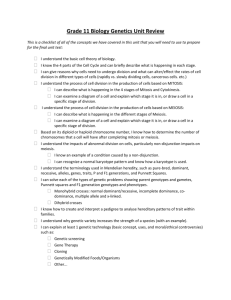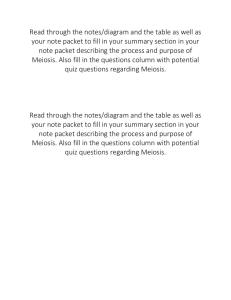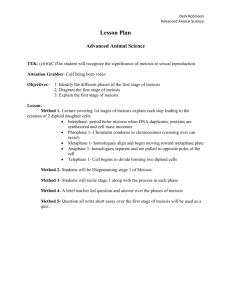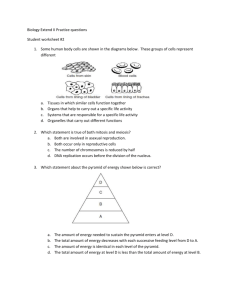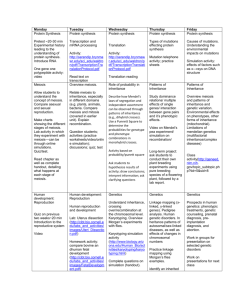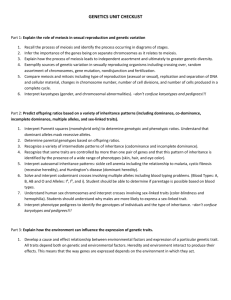CoRE Big Ideas Meiosis - EDF4402-Unit4-AOS2
advertisement
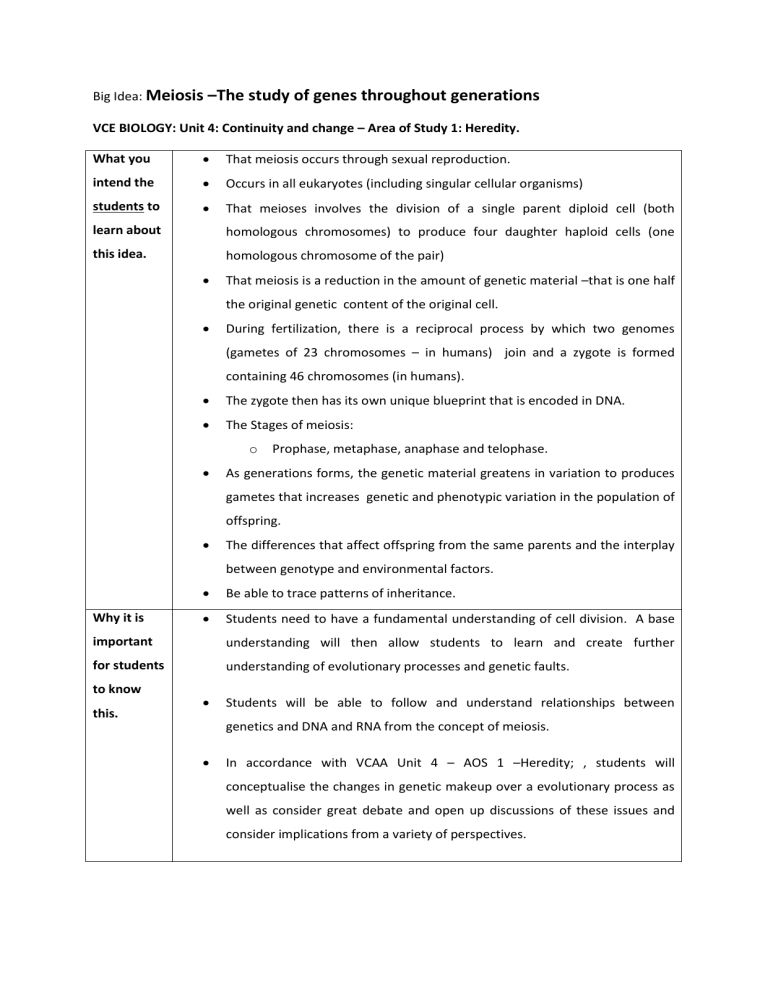
Big Idea: Meiosis –The study of genes throughout generations VCE BIOLOGY: Unit 4: Continuity and change – Area of Study 1: Heredity. What you That meiosis occurs through sexual reproduction. intend the Occurs in all eukaryotes (including singular cellular organisms) students to That meioses involves the division of a single parent diploid cell (both learn about homologous chromosomes) to produce four daughter haploid cells (one this idea. homologous chromosome of the pair) That meiosis is a reduction in the amount of genetic material –that is one half the original genetic content of the original cell. During fertilization, there is a reciprocal process by which two genomes (gametes of 23 chromosomes – in humans) join and a zygote is formed containing 46 chromosomes (in humans). The zygote then has its own unique blueprint that is encoded in DNA. The Stages of meiosis: o Prophase, metaphase, anaphase and telophase. As generations forms, the genetic material greatens in variation to produces gametes that increases genetic and phenotypic variation in the population of offspring. The differences that affect offspring from the same parents and the interplay between genotype and environmental factors. Why it is Be able to trace patterns of inheritance. Students need to have a fundamental understanding of cell division. A base important understanding will then allow students to learn and create further for students understanding of evolutionary processes and genetic faults. to know this. Students will be able to follow and understand relationships between genetics and DNA and RNA from the concept of meiosis. In accordance with VCAA Unit 4 – AOS 1 –Heredity; , students will conceptualise the changes in genetic makeup over a evolutionary process as well as consider great debate and open up discussions of these issues and consider implications from a variety of perspectives. What else The role that science is playing in modifying genetic makeup. Designer babies you know (Movie ; My sister’s Keeper) , cloning – Dolly the Sheep. Ramifications of both about this and open for discussion at a later date. This will obviously be an interesting idea (that subject on debate on not only from a science point of view, but from a moral you do not and other perspective view. This will lead to a more thorough understanding intend from AOS 1 students to know yet). Generation of stem cell development and the idea of creating ‘replacement parts’ such as kidneys, ears and the like regeneration of nerve cells. Transplants and organ donations – why is there rejection rates? These are some ideas which are built from understanding how meiosis occurs and then the transitional phases of cell development. Students should be able to formulate ideas on these concepts gained from their accrued knowledge of genotypes, genetic predisposition and cellular makeup. Knowledge This idea is a concept which is a difficult one to understand particularly when about teaching the different phases of meiosis. There is a great deal of phrases and students’ concepts to learn and difficult to link initially. thinking There is a lot of belief in the science rather than the seeing in the science. /difficulties Particular care will need to be taken to demonstrate the stages of meiosis and connected the effects of genetic changes though same parent offspring to offer the with students a real conception of idea. teaching this idea. The idea will need to be fully explored at the cellular level in order for the next level of understanding that formulates genetics and heredity. Students will need to understand the links of molecular genetics and genes as units of inheritance. Teaching Think, pair and share concept of how we develop as people. Introduce the idea procedures of genetics and genetic transfer. Incorporate ideas such as where our colour of (and eyes come from, or why we look more like one parent or another. This will give particular an understanding of the student’s awareness of genetics and idea of heredity. reasons for using these to engage From this introduce the concept of cells, cell division with specific reference to meiosis. This will become the building block knowledge of heredity. Pictorial representation of the stages of meiosis. It can be useful so that a with this visual representation is available as well as the theoretical background behind idea). the pictures. Links such as the following could be useful: o http://www.accessexcellence.org/RC/VL/GG/meiosis.php o http://www.youtube.com/watch?v=D1_-mQS_FZ0 o http://www.youtube.com/watch?v=jdQeKjEsj0U&feature=related o http://www.umanitoba.ca/Biology/lab5/biolab5_2.html Demonstrated understanding of concept through handouts with thinking questions such as from: o http://serendip.brynmawr.edu/sci_edu/waldron/pdf/MitosisMeiosisProt ocol.pdf Not only can these raise discussion questions, they are also information which can be cut out and pasted into workbooks for future reference. Use of ICT resources and interactive whiteboards to develop concept maps that all students can have discussion and add to in regards to the meiosis, cell division and change, genetic information and makeup, and perhaps evolutionary concepts. Use of practical demonstration and microscopes to look at cells and their microscopic changes as cell division occurs, or alternatively through the use of internet and images that can be shown to demonstrate cell division. Also the use of humour to help remember difficult concepts. Specific http://www.youtube.com/watch?v=iCL6d0OwKt8 Have students work in four small groups where they are required to work on a ways of different stage of meiosis. They are then required to provide a demonstration ascertaining to the class in a manner which is understood by their peers. students’ understandi Have students develop their own concept maps to enable them to understand the process of meiosis, how DNA is constructed and how genetic traits are ng or inherited. This could be as an extended experimental idea whereby they may confusion look at genetic traits that have evolved over time, breaking down to the cellular around this level. idea Open up key discussions about meiosis, genetics, DNA and heredity and ask (include questions in class, looking for the correct answers and correct terminology likely range which would show understanding of concept. of Use of worksheets or flow charts to show application of ideas and knowledge. responses). Example from: o http://www.dna-sequencing-service.com/dna-sequencing/meiosisflow-chart/ o http://2.bp.blogspot.com/_Dd9opeav8Rk/SvL8j7WKdVI/AAAAAAAAA JE/pIrNVGOSkMs/s1600-h/Flow+Chart.gif POE (Predict, observe, explain). Have students look at a range of genetic comparisons from evolution to demonstrate understanding of concept. Sources: Biology: Victorian Certificate of Education Study Design, VCAA 2005, http://www.vcaa.vic.edu.au/vce/studies/biology/biologystd.pdf accessed 12 August 2010. Loughran, J., Berry, A. & Mulhall, P. (2006). Understanding and Developing Science Teachers’ Pedagogical Content Knowledge. Sense Publishers: Monash University, Victoria Australia. http://en.wikipedia.org/wiki/Meiosis http://www.accessexcellence.org/RC/VL/GG/meiosis.php http://www.youtube.com/watch?v=D1_-mQS_FZ0 http://www.youtube.com/watch?v=jdQeKjEsj0U&feature=related http://www.umanitoba.ca/Biology/lab5/biolab5_2.html http://serendip.brynmawr.edu/sci_edu/waldron/pdf/MitosisMeiosisProtocol.pdf http://www.youtube.com/watch?v=iCL6d0OwKt8 http://www.dna-sequencing-service.com/dna-sequencing/meiosis-flow-chart/ http://2.bp.blogspot.com/_Dd9opeav8Rk/SvL8j7WKdVI/AAAAAAAAAJE/pIrNVGOSkMs/s1600h/Flow+Chart.gif
